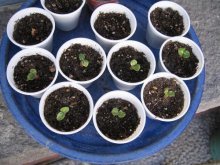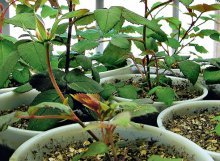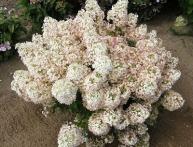Queen of flowers from seeds, or how to plant rose seeds
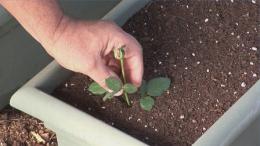
Wild rose hips and garden roses are representatives of the Rosehip genus. Among the cultivated roses there are both varieties and hybrids obtained through long-term selection, as well as representatives of various forms of wild rose hips.
When starting to propagate roses, it is important to consider that many varieties and hybrids on their own roots in temperate climates can only be grown indoors. It is possible to grow heat-loving roses outdoors only by grafting their cuttings onto the roots of frost-resistant rose hips.
Therefore, you need to plant rose seeds taking into account the local climate, or you need a greenhouse for further cultivation of the resulting seedlings.
Content:
Where can I get rose seeds?
Many hybrid rose forms do not produce full-fledged seeds that convey the quality of the original plant. Therefore, seeds of garden forms of wild rose hips rugosa (Rugosa roses) or varietal roses obtained on its basis by crossing with other wild roses are suitable for cultivation.
Fruits with full seeds of polyanthus roses ripen very well. This may be due to the parent form, Rosa rugosa.
Like wild rose hips, roses have fleshy round fruits in place of flowers. They start out green and become red or yellow when fully ripe. Each fruit contains several fairly dense, highly pubescent seeds.
To obtain seeds for planting, you need to free them from any remaining fruit pulp and lightly dry them on a sheet of paper for several hours, but not more than a day. Drying rose seeds for a long time can negatively affect their germination.
Prepare clean river sand in advance and mix the seeds with it, pour the mixture into a cardboard box or box, place the seeds in a cool place. The temperature during storage should be kept from 0 to + 3 degrees. The vegetable drawer of the refrigerator is suitable for this; it is important to check the box with seeds once or twice a month and spray it with water if necessary.
If it is not possible to prepare seed material, then you can purchase rose seeds in specialized stores, including online. To successfully obtain rose seedlings from seeds, they must be sown correctly and provide favorable conditions for further germination.
Sowing rose seeds
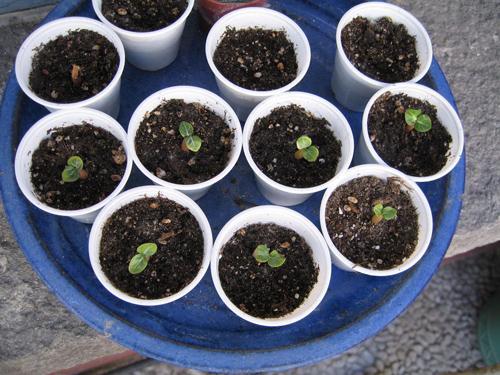
From the experience of gardeners, it is known that rose seeds are quite difficult to germinate and take a long time to germinate. A long period of rest at sufficiently low temperatures can somewhat speed up this process. Therefore, you can sow rose seeds in several ways:
- in open ground in autumn
- in open ground in spring
- for seedlings in pots at the end of winter
Autumn sowing of rose seeds
Before sowing in open ground Collected or purchased rose seeds do not need to be pre-conditioned at low temperatures; this will happen naturally in winter conditions. But you can still pre-soak them in a growth stimulator.
Before frost sets in, you need to dig up the soil in the rose bed. You can first add peat, compost, humus.
Make grooves 3 - 4 cm deep in the prepared soil.Sow seeds at a distance of 10 - 15 cm from each other. Cover the grooves with soil. In winters with little snow, you can cover the bed with covering material or peat.
The more rose seeds are sown, the greater the likelihood of obtaining the required number of seedlings in the spring. Mass seed germination for autumn sowing it begins in mid-April or a little later.
Spring sowing
It is advisable to prepare a bed for spring sowing in the fall, but this can also be done in the spring after the soil has thawed. Before sowing, soak the seeds for several hours in a growth stimulator.
Sow in pre-moistened furrows at a distance of 10 - 20 cm. Plant the seeds to a depth of 1 cm - to 3 cm.
Sowing seeds for seedlings
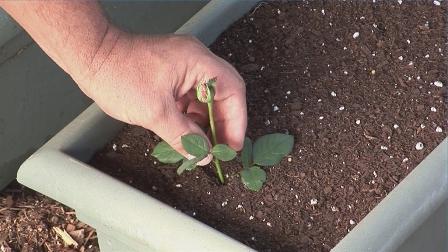
After storing rose seeds at low temperatures for several months, you can sow them for seedlings at home. It is best to do this in late February - early March.
A rose grown through seedlings can produce abundant flowering already in the first year, although, as a rule, all the beauty of the flowering of a rose bush begins to appear in the second or third year of life.
To sow rose seeds for seedlings, you need to fill pots or boxes with soil from a mixture of earth, peat, and sand. Place seeds, previously soaked in a growth stimulator, on the surface of the soil, lightly pressing them.
Cover the top with a thin layer of clean sand. Moisten the surface of the sand well by sprinkling it with water. Then cover the seedling boxes with polyethylene and place them in a fairly cool place.
Caring for rose seedlings
For proper development of seedlings, it is necessary to provide them with a good light regime and timely moisture. You should not keep boxes of seedlings in direct sun, but even in too dark a room the sprouts will be weak and overly elongated. After two or three true leaves appear on the seedlings, they should be planted in separate containers of 1 to 2 plants.
It is very rare to get all the seedlings of the same high quality, so you should choose the strongest, straightest specimens for replanting. In a few days after transplant, seedlings can be fed with a mineral mixture.
Strong bushes are planted in a permanent place in open ground in early May. In the first summer they need several feedings per season.
It is worth saying that of all the methods of propagating roses, growing them from seeds is the most time-consuming and painstaking method, but it justifies itself in that the bushes are more resilient and even if the ground parts are damaged by severe frosts, they are completely restored due to a good root system.
Educational video about growing roses with seeds:
Interesting information about the vegetable garden

